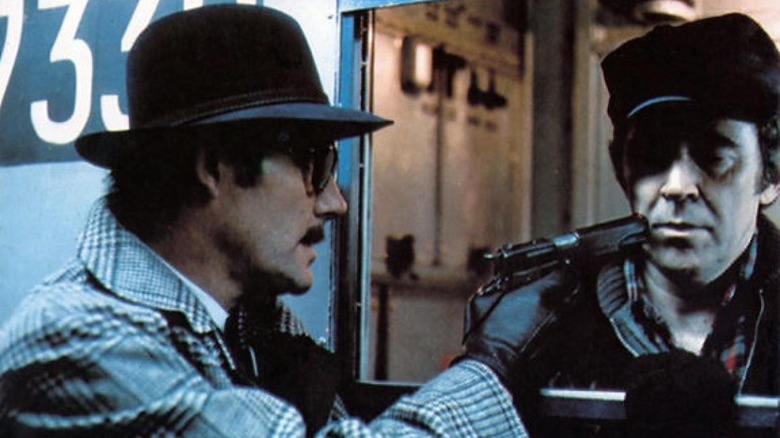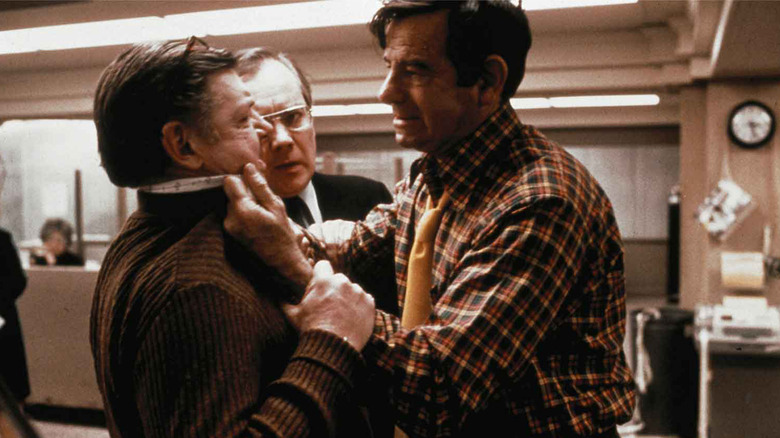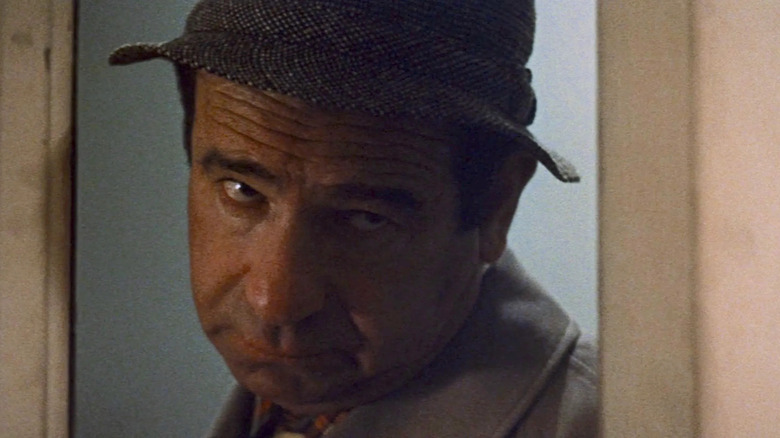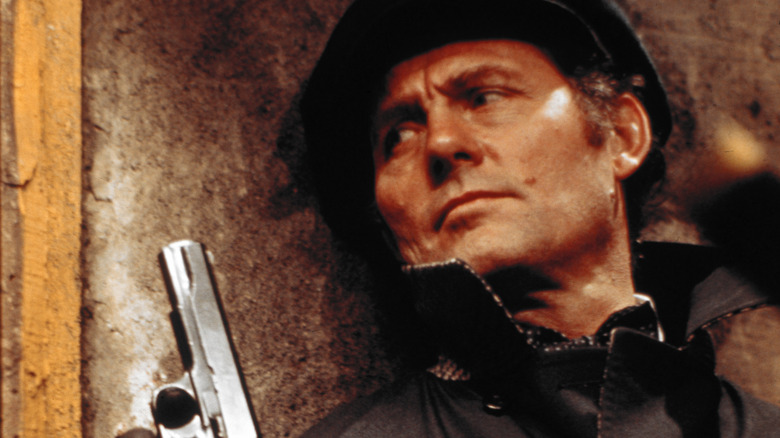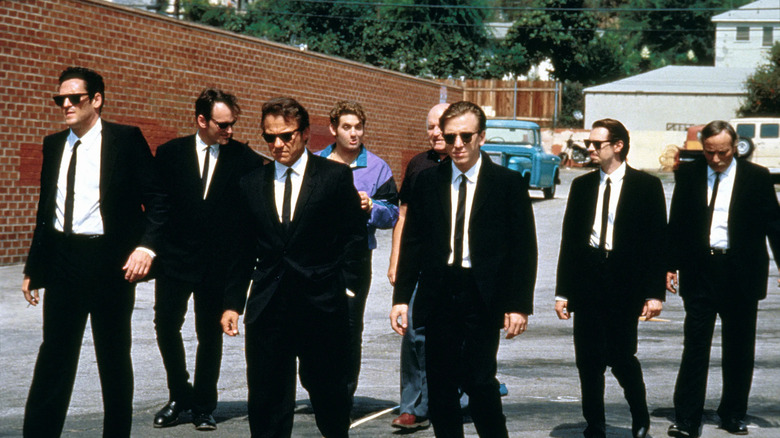This Gritty Heist Thriller Inspired Tarantino's Color-Coded Nicknames In Reservoir Dogs
Do you remember your first contact with a Tarantino movie? Mine was "Pulp Fiction," and I was almost levitating out of my seat from the moment "Misirlou" burst out over the opening credits. Hell, I even got a big kick out of the title font. The movie hadn't even started properly and already I couldn't wait to see it again. As a 16-year-old ducking into an 18-rated movie with his fake ID, it was simply the coolest thing I'd ever seen.
Of course, I rented "Reservoir Dogs" straight away afterwards. When it comes to Quentin Tarantino, you just have to admire the brass balls on the guy — especially then. His first time directing a movie, he casts himself alongside Keitel, Roth, Madsen, and Buscemi, and gives himself the "Like a Virgin" speech in the opening scene. He made it all look so effortless: the music choices, the slow-mo strutting, the now-signature trunk shot, and the audacity of making a heist movie where we never see the actual heist.
One thing that struck me in particular was the color-coded nicknames. A gang of crooks brought together for a robbery, handed out aliases to prevent them letting their real identity slip. It's a great scene, elevated by the guys complaining about their colors; Mr. Pink (Buscemi) and Mr. Brown (Tarantino) quibbling about what bodily parts or functions their respective hues might be associated with. It's also a neat touch that the loose cannon, Mr. Blonde (Madsen), gets a nickname that isn't actually a color, indicating that he is different from the others. They're all capable of violence but this guy is a sadistic nut job.
Back then, the idea that a director might take stuff from other movies and put it in theirs was new to me. I naively thought that everything came fresh from the filmmaker's imagination, unless it was a remake or an adaptation. It blew my mind when I discovered that Tarantino could make a career robbing his favorite bits from other flicks and turning them into something new. That's when I found out that the color-coded nickname thing came from an old '70s movie I'd never heard of: "The Taking of Pelham One Two Three."
So what happens in The Taking of Pelham One Two Three?
"The Taking of Pelham One Two Three" takes place in a grey, grimy New York City in the mid-'70s, which is possibly my favorite place in all of cinema with the possible exception of Rick's Cafe in "Casablanca." Down in the subway, four men board a train at different stops, almost unnoticed by the jaded commuters on the 1.23 p.m. train from Pelham. They each wear similar overcoats, hats, glasses and mustaches, and they're all armed. Once aboard, they hijack the train and bring it to a halt in a tunnel, from where they call in their demands. The city must pay $1 million dollars in cash within one hour, otherwise the passengers will start dying.
This is where we get the "Reservoir Dogs" connection. The ringleader, played with typical tight-lipped menace by Robert Shaw, is Mr. Blue, a cold-hearted mercenary that we are in no doubt will carry out his threats. Martin Balsam is Mr. Green, a former subway driver with a beef with his old employers and an unfortunate sniffle that pays off beautifully in the final scene. The gang is rounded out by Earl Hindman as the stammering makeweight Mr. Brown, and Hector Elizondo as the sleazy psycho Mr. Gray, a guy so crazy that the mafia kicked him out for being too violent.
Up in the nicotine-stained offices of the Metropolitan Transportation Authority (MTA), Lieutenant Zach Garber (Walter Matthau) takes the role of negotiator as city officials fall over one another trying to round up the ransom within the deadline. Can he hold things together long enough to save the passengers and catch the crooks?
A hardboiled role for Walter Matthau
"The Taking of Pelham One Two Three" is pure class, a tight and suspenseful heist thriller that announces its intentions from the first brassy notes of David Shire's mean, driving jazz score. Of all those gritty classic movies set in New York in the '70s, it is probably the most New York, at least in my fantasy movieland version of the city. By that I mean everyone is cynical and barking at each other with full "I'm walkin' here!" fury. It's a movie that feels truly alive with a colorful microcosm of side characters, all irate and treating the hijacking as just more crap they don't need in their day. At the same time, despite the grumbling and the grievances, it also shows the city coming together in a deadly crisis.
If much of the humor in "The Taking of Pelham One Two Three" comes from these gruff New Yorkers snarling at one another (best line: "What do they expect for their lousy 35 cents, to live forever?") the rest comes from Matthau's performance as Garber. Matthau was such a versatile actor beyond his comedic roles, and he is perfectly cast as the laconic transit cop playing cat-and-mouse with the ruthless Mr. Blue. He's just as world-weary as his colleagues, but more empathetic, standing just to one side of the cacophony of angry voices with a quizzically raised eyebrow and a wry comment. The role was the last and greatest of his unusual run of great hardboiled '70s performances, after "Charley Varrick" and "The Laughing Policeman."
If the film is notable for influencing Tarantino and his colorful nicknames, "The Taking of Pelham One Two Three" is also a proto-"Die Hard," with the verbal sparring between Garber and Mr. Blue prefiguring the similar relationship between John McLane and Hans Gruber fourteen years later. It has all the same elements, with an audacious plan staged in an enclosed location, a group of hostages, a cunning criminal mastermind, and a wise-cracking cop trying to save the day.
Matthau and Shaw had great chemistry offscreen too
Shaw was also brilliantly cast as Mr. Blue. The hard-drinking actor started out in movies in early '50s and was later Oscar-nominated for his performance in "A Man For All Seasons," where he lost out to Matthau for his role in "The Fortune Cookie." Yet, he didn't reach the peak of his popular appeal until the '70s, and this is one of his best roles just four years before his death at the age of 51, sandwiched between villain duty in "The Sting" and the surly old salt Quint in "Jaws."
Although Matthau and Shaw only appear in one scene together, their dynamic defines the movie. The chemistry between them wasn't just great acting, as the pair also became friends offscreen. In Matthau, Shaw had found a Stateside drinking buddy, and they played ping-pong and ate at fine restaurants together (via Robert Shaw: The Price of Success):
The one advantage of Brooklyn was Gage & Tollner's, a long-established restaurant – the waiters wore a star for every 10 years of service, and some had five stars – which served oysters, littleneck clams and 'surf and turf.' Shaw and Matthau lunched there if filming permitted. It was an interesting contrast of personality, Matthau very much at home with himself full of homely aphorisms; Shaw bright, intelligent, but ultimately restless and uneasy about his place in the scheme of things.
Here is another point on my fantasy cinematic map of New York, somewhere between taking a subway ride out to Coney Island with "The Warriors" and hanging out with the Village People on the set of "Can't Stop the Music;" sitting in a famous old restaurant listening to Matthau and Shaw trade stories and banter over drinks and big plates of sea food.
Tarantino helps Pelham get a new lease of life
Quoting the color-coded nicknames from "The Taking of Pelham One Two Three" in "Reservoir Dogs" isn't the biggest lift from another movie that Tarantino has ever committed. That honor must surely go to "Kill Bill: Vol 1." When I saw "Lady Snowblood" recently, I couldn't believe how much the cinematic magpie took from that movie.
The "Pelham" callback is still a significant one, as the matching outfits also play a big part in the heist. As the director explained in an interview:
"It actually has a basis in reality, because a lot of times when robbers will commit a robbery, they want to adopt a uniform, could be suits, could be anything, could be Raiders jackets, it could be parkas ... the idea is that they go in and they do the robbery and they all look alike, alright, so when they leave and the cops come back later and go, 'Okay, what did they look like?' 'I don't know, they looked like a bunch of black suits, how do I know? Maybe one guy had red hair, maybe, I don't know.' They fail to be distinguishable from one another."
One great thing about Tarantino is that his references give us movie buffs a great source of cool older movies that we otherwise might not have bothered checking out. Without "Django Unchained" I may never have found my way to Sergio Corbucci's wild source text, "Django." "The Taking of Pelham One Two Three" wasn't as widely known until Tarantino started talking about it in interviews (via New York Times), as it was a film that got a little lost in the mix when it came to the deluge of fantastic cinema coming out of the States in the '70s.
Since "Reservoir Dogs," "Pelham" was remade twice, firstly as an anonymous TV movie and then as a hollow big-budget Tony Scott version with Denzel Washington as Garber and John Travolta in full panto villain mode as Mr. Blue. Forget those versions exist and get on the original straight away if you haven't seen it already. It's a great ride.
